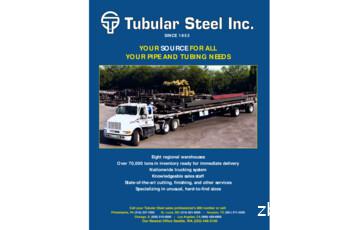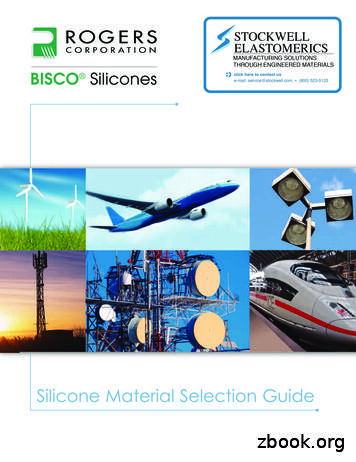ITRS, SEMI And ASTM Guidelines For Semiconductor (UPW .
ITRS, SEMI and ASTM Guidelines for SemiconductorUltrapure Water (UPW) Productionand the Consequences for UPW Particle MetrologyDavid Blackford, Ph.D. Fluid Measurement Technologies, Inc.St. Paul, MinnesotaUniversity of Arizona TeleSeminarMay 3,2012
The International Technology Roadmap for Semiconductors (ITRS) is a setof documents produced by a group of semiconductor industry experts. Theseexperts are representative of the sponsoring organizations which include theSemiconductor Industry Associations of the US, Europe, Japan, South Koreaand Taiwan.Semiconductor Equipment and Materials International (SEMI) is a tradeorganization of manufactures of equipment and materials used in thefabrication of semiconductor devices. Among other activities, SEMI acts as aclearinghouse for the generation of standards and guidelines.American Society for Testing and Materials (ASTM), is an internationalstandards organization that develops and publishes voluntary consensustechnical standards for a wide range of materials, products, systems, andservices for all industries.Fluid Measurement Technologies2
ITRS Requirements for 2011 and BeyondFluid Measurement Technologies3
SEMI F63’s Recommended UPW SpecificationsFluid Measurement Technologies4
Process Risk Calculation for eachIndividual Ion or MetalSeverity of Deposition1 unlikely, 2 minor, 3 moderate, 4 major, 5 severeOccurrence1 yearly, 2 quarterly, 3 monthly, 4 weekly, 5 dailyDetection1 continuous, 2 hourly, 3 daily, 4 weekly, 5 monthlyLowriskHighriskFluid Measurement Technologies5
SEMI F63’s Recommended UPW Specification forIons and MetalsFluid Measurement Technologies6
ASTM Standard Guide for Ultra-Pure Water Used in the Electronics andSemiconductor IndustriesFluid Measurement Technologies7
SEMI F63’s Recommended UPW SpecificationsFluid Measurement Technologies8
ITRS Requirements for 2011 and BeyondFluid Measurement Technologies9
Light‐Scattering Event Monitors(also called Optical Particle Counters, OPCs)For two decades the semiconductor industry has relied on OPCs to detectparticles in UPW and chemicalsOPCs have always had limitations:A Particle Counter’s response is based on how it measures white, spherical,PSL (plastic) beads.Different manufacturers use different wavelengths, different angles ofcollection and different definitions of illuminated area. Two OPC’s rarelyagree with each other.All Particle Counters measure an equivalent optical Diameter.The current detection limit is 50nm, with the possibility of 40nm and 30nmin the near futureOPCs have little chance of meeting the future requirements of the ITRSRoadmap.Fluid Measurement Technologies10
The counting efficiency for 50nm rated Optical Particle Countersis only a few percent at best at 50nm (data courtesy of ParticleMeasuring Systems)Fluid Measurement Technologies11
Task Force Rational: Optical Particle Counters (OPCs) have reached a practicalmeasurement limit of 40 nm, with a counting efficiency of only a fewpercent at this size. The ITRS Roadmap has a critical particle size of 25 nm for 2011. Lack of particle metrology and marginal filtration efficiency at 25nmsubstantially increases the risk to the next generation of the wafermanufacturing technology. UPW ITRS has suggested a risk mitigation strategy based on off-linevalidation of the filter performance. Until the particle metrology gap issolved, this approach mitigates risks and gets users closer to ITRSrequirements. Current methods of filter performance characterization using 50-200nmPSL spheres and OPCs, and extrapolating performance to 5-15nm isinadequate for guaranteeing filter performance at the extrapolated size. A new method of quantifying filter performance is required for filterswith a pore size of 5-15 nm.Fluid Measurement Technologies12
Fluid Measurement Technologies13
Courtesy of CT AssociatesFluid Measurement Technologies14
Methodology: Three Phases of SievingFiltration Initial– Retention of an un‐loaded filter Loading– Retention decreases as smaller pores in the filter are selectivelyclogged– Retention begins to decrease almost immediately Cake filtration– When filters are sufficiently loaded the retained particles begin toretain smaller particles– This is expected to increase the differential pressure– Does not occur until the filter is heavily loaded Based on historical data, UPW filters do not show increase in thedifferential pressure unlikely to occurFluid Measurement Technologies15
Particle chemistry can have a significant effect on measured filter retention100Retention (%)806040Retention of different 30nm particlestypes by a commercially available UPWfilter 00.1250.1500.1750.200Fractional coverage (Monolayers)100Retention (%)806040 Each filter was tested with a sequence ofparticle types. Si particle curves display sieving mechanism In all cases the challenge concentration 00.1250.1500.1750.200Fractional coverage (Monolayers)Fluid Measurement Technologies16
PSL is no longer mono-sized at 30nmColloidal gold particles are as mono-sized at Si, but require surface modificationto reduce capture by absorptionFluid Measurement Technologies17
Particle type comparisonParticleTypeSizesAvailable“Real World”?Sieving only?Cost ofparticles pergramPSLYesNoCan be achieved by addingsurfactant. 1,800ColloidalGoldYesNoCan be achieved by surfacemodification. 23,000ColloidalSilicaYesYesYes ? 0.08Colloidal silica appears to be the best choice.Fluid Measurement Technologies18
Colloidal SilicaTypical end uses for colloidal silica include coatings forcorrosion control, ink receptive papers, metal casting, refractoryproducts, and catalysts.Commercially available colloidal silica were never intended as astandard for particle counters.There is no such entity as a NIST or AIST traceable colloidalsilica standard, and there probably will not be for theforeseeable future.Fluid Measurement Technologies19
New Particle Counter being Developed by CT Associates and TSIFluid Measurement Technologies20
Only when a particle experiences an equal force from the electric field and the drag dueto the gas flow, can the particle exit through the Monodisperse Slit.Fluid Measurement Technologies21
Schematic of Condensation Particle CounterFluid Measurement Technologies22
New Particle Counter being Developed by CT Associates and TSIFluid Measurement Technologies23
Particle size distributions for Ludox colloidal silica suspensionsFluid Measurement Technologies24
Colloidal silica mean size 18nmFluid Measurement Technologies25
Particle Challenge Test Skid built at Pall CorporationFluid Measurement Technologies26
Fluid Measurement Technologies27
Filtrate and challenge PSDs 3.5 hours into 3E9 challengeFiltrateChallenge3.0e 10Effect of Particle Loadingon Filter Retention2.5e 102.0e 101.5e 101.0e 105.0e 90.056789 10152025304050Filtrate and challenge PSDs 14 hours into 3E9 challengeParticle diameter (nm)3.5e 10Differential number concentration(d #/mL / d log (Dp))Differential number concentration(d #/mL / d log (Dp))3.5e 10FiltrateChallenge3.0e 102.5e 102.0e 101.5e 101.0e 105.0e 90.056789 101520253040Particle diameter (nm)Fluid Measurement Technologies2850
Retention of different sized silica particles - 3E9 challenge10Effect of Particle Diameterand Loading on FilterPerformanceLRVSM30HS4010.1567891015Particle Diameter (nm)202530Overall HS40 LRV - 1.3Overall SM30 LRV - 0.790% efficient 1 (LRV)99% efficient 2 (LRV)99.9% efficient 3 (LRV)Fluid Measurement Technologies29
ITRS Requirements for 2011 and BeyondFluid Measurement Technologies30
Voltaire's Dictionnaire Philosophique (1764)“The pursuit for perfection becomes theenemy of good enough”Fluid Measurement Technologies31
Conclusions: The Task Force has made significant progress in just 12 months The boundary conditions for testing nanometer pore size filterswith a 5-15nm challenge have been established A draft filter test protocol has been written A filter test skid has been built at Pall Corporation and the firstfilters tested A draft of the test method has been written and will be submittedfor SEMI ballot this month.Fluid Measurement Technologies32
International Technology Roadmap for Semiconductors (ITRS) is a set of documents produced by a group of semiconductor industry experts. These experts are representative of the sponsoring organizations which include the Semiconductor Industry Associations of the US, Europe, Japan, South Korea and Taiwan.
ASTM C42 ASTM C293 ASTM C457 7066 SW 44th ST Miami, FL 33155 Contact: Andres Diaz Abdias H. Saenz, P.E. ASTM C215 Ph 305-668-5792 Fax 786-513-3754 ASTM C900 ASTM C4435 ASTM C597 ASTM C642 Jaime Reyes, P.E. ASTM C174 ASTM C215 ASTM D698 ASTM D2167 ASTM C1585 ASTM D4263 ASTM D4564 ASTM D4580 ASTM C1740 ASTM D4263 ASTM
astm a 966, 135, 136 astm d 1298, 139 astm d 1500, 139 astm d 2161, 141 astm e 1025, 63 astm e 1032, 59 astm e 11, 136, 137 astm e 1135, 102, 107 astm e 1316, 80 astm e 1416, 59 astm e 1417, 106–108, 114 astm e 1444, 131–138, 141, 142 astm e 1647, 69 astm e 165, 109, 115 astm e 1742, 59 astm e 709, 132 astm e
*astm a182 *astm a564 *astm a213 astm a778 *astm a249 asms-5613 *astm a269 asms-5639 *astm a276 asms-5640 *astm a312 asms-5647 . astm a512 cdbw & cdew astm a513 dom astm a519 cdsm sae j524/j525 hydraulic ams 5050 fluid line specification astm a135 astm a178 grd a astm a214 astm a500 grd b astm a513 type 1,2 awwa c200
JIS G3459, JIS G3463. GOST 9940, GOST 9941 Nickel Alloy Pipe Specification: ASTM B111, ASTM B161, ASTM B163, ASTM B165, ASTM B167, ASTM B338, ASTM B407, ASTM B423, ASTM B444, ASTM B619, ASTM B622, ASTM B626, ASTM B668, ASTM B677, ASTM B829 or Standards stipulated in the technical agreement. Add:No.3, Jiangnan Road, Jiangnan Industrial Park, Songyang, Zhejiang Province, China Cell: 86-159 .
ASTM D 1056 ASTM D 1056 ASTM D 412 ASTM D 412 ASTM E 162 ASTM E 662 SMP-800- C ASTM E 595 ASTM E 595 ASTM E 595 Rogers Internal ASTM D 746 ASTM D 150 ASTM D 149 ASTM D 495 ASTM D 257 ASTM C 518 Flame Resistance Flame Spread Index (Is) Smoke Density (Ds) Toxic Gas Emissions Rating Total Mass Loss Collected Volatile Condensible Materials (CVCM) Water
Flexural (ASTM D790), Tensile (ASTM D638) Adhesion (ASTM D4541 and ASTM D3359) Sag resistance Dry film thickness Adhesion Hydrostatic leakage test (ASTM F1216) CIPP ASTM D5813 ASTM F1216 ASTM F1743 ASTM F2019 Tensile (ASTM D638 and ASTM D2290) Flexural (ASTM D790) Tensile Creep (ASTM D2990) Burst (ASTM D1599)
ASTM D638 TAS201 ASTM F476 TL-144 International Accreditation ASTM C1167 ASTM E773 ASTM E783 ASTM E987 ASTM E1105 ASTM E1886 Certificate of Accreditation Services Inc. TAS203 ASTM B117 ASTM C39 UL 580 UL 1897 ASTM G154 ASTM D635 ASTM G85 ASTM D790 TAS201 TAS202
ASTM A335 Gr P9 ASTM A234 Gr WP9 ASTM A182 Gr F9 ASTM A217 Gr C12 Carbon Steel ASTM A333 Gr 6 ASTM A420 Gr WPL6 ASTM A350 Gr LF2 ASTM A352 Gr LCB ASTM A320 Gr L7 Alloy ASTM A194 Gr 7 Low-Temp ASTM A333 Gr 3 ASTM A420 Gr WPL3






















